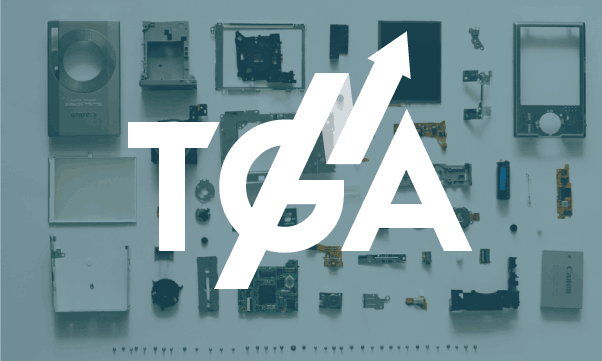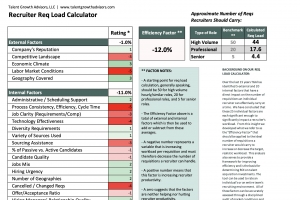The Most Important Recruitment Metric: Quality of Hire

Imagine for a moment that you are driving a manual shift transmission car down the highway. While the speed limit is marked 70 mph, signs also note that the minimum speed is 40 mph. If you want to drive this stretch of highway in an effective way, you will focus on staying within the speed range of 40 to 70 mph. If you want to be efficient too, you could also pay attention to optimizing your fuel usage.
During this high-speed drive, there are many sub-processes occurring behind the scenes to allow you to maintain your speed within the desired range while optimizing fuel usage. A tachometer, for instance, helps you monitor your car’s revolutions per minute (rpm) to keep from overheating the engine. A temperature gauge, oil pressure gauge and other sub-processes also are essential to achieving the effectiveness and efficiency of the driving goals that you have established. Each of these sub-processes has a target built into its measurement, creating a metric against which you can gauge progress toward your goals.
While there may be a dozen other supportive data points being measured, the metric that matters most in this driving scenario is speed, and the speedometer is the gauge (you won’t get a ticket for being low on oil or even for using too much gasoline!). The other metrics give you additional information to help achieve and sustain your target speed over time as well as early warning of problems to resolve before they impair you. Just as your car performs against established metrics, so too should talent management. And, as with your car, not all metrics are created equal – many of them simply measure sub-processes that help support a favorable measurement of your main goal.
You’re Only as Good as the People You Hire
There are dozens of sub-process measurements that are important for managing the overall talent process, from the time it takes to fill a vacancy to performance review scores. So, how do you decide which are the most essential metrics to achieve across the entire connected talent process? How do you differentiate between the “oil gauge” and “speedometer” as measurement tools to successfully guide your efforts?
For CEOs, the car-to-talent analogy is particularly fitting. After all, a CEO’s main talent goal is to have plenty of the right gas in the tank, so they must pay attention to their talent strategy in order to appropriately fuel their organization and achieve their vision. To that end, the CEO grapples with challenges like: Do we drive development from within or hire from outside? (Diesel or regular?) Do we invest in high potential programs or improved onboarding? (High test or ethanol?) Is our talent pool deep enough? (How many gallons are needed to fill the tank?)
According to PWC’s 17th annual survey of CEOs, the CEO perspective is clear: The most important metric to monitor is the availability of quality talent – 63% said availability of skills was a serious concern. After all, in the wise words of McDonald’s leader Ray Kroc, “You’re only as good as the people you hire.” But, the CEO’s biggest concern is HR’s ability to do something about talent quality – only 34% feel that HR is ready for the task.
Since talent quality has a direct impact on the creation and value of intellectual capital, we agree with CEOs that talent quality is the only metric that matters in an intellectual capital world. More than any other factor, talent quality has the greatest potential to determine the success or failure of business investments.
Even if talent is deployed on time and at the right cost, if it is not fully up to the task, there will likely be a permanent impact on the investment outcome, and goals will have to be revised downwards. When this occurs, it puts pressure on every subsequent dollar invested and the negative impact can easily snowball. In the worst-case scenario, investments will fail before or even right after launch, burning the entire invested amount.
Red flags to look for when it comes to identifying talent quality problems within an organization include:
- Increased frequency of underperforming new products (e.g., recall frequency among automobile manufacturers).
- Negative change in company financial and market performance versus industry competitors over a sustained period (e.g., Circuit City vs. Best Buy, J.C. Penney vs. Target, Zenith vs. Sony).
- Failure to evolve business direction in the face of mega-trend industry changes (e.g., Polaroid, Kodak, Blockbuster).
- Increased turnover in core talent areas (reviews and trends on sites like Glassdoor highlight these issues).
Measuring Talent Quality
If it’s the quality of talent that matters above all other human capital metrics, then we must understand how to measure talent quality for critical roles in order to find improvement opportunities and determine how best to hire for top talent. CEOs need to demand the creation of measurable, business-based talent strategies, and HR needs to facilitate strategic discussions about critical success factors and the roles that are most important to achieving them. In an upcoming post, we will explore the four essential data elements to measure talent quality and enable market value acceleration.
Want to learn more about how business value, intellectual capital and talent are connected? Send us a note - or check out or book: Talent Valuation: Accelerate Market Capitalization through Your Most Important Asset.
Share this Article
Learn more about our unique approach to Talent Strategy Formulation.



